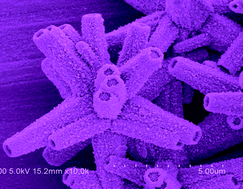Hierarchical ZnO micro/nanoarchitectures: hydrothermal preparation, characterization and application in the detection ofhydrazine
Abstract
In the present work, we report the successful preparation of hierarchical

* Corresponding authors
a
College of Chemistry and Materials Science, Anhui Key Laboratory of Functional Molecular Solids, Anhui Normal University, Wuhu, P. R. China
E-mail:
niyh@mail.ahnu.edu.cn
Fax: (+86)553-3869303
b Centers of Modern Analysis, Nanjing University, Nanjing, P. R. China
In the present work, we report the successful preparation of hierarchical

 Please wait while we load your content...
Something went wrong. Try again?
Please wait while we load your content...
Something went wrong. Try again?
Y. Ni, J. Zhu, L. Zhang and J. Hong, CrystEngComm, 2010, 12, 2213 DOI: 10.1039/B923857N
To request permission to reproduce material from this article, please go to the Copyright Clearance Center request page.
If you are an author contributing to an RSC publication, you do not need to request permission provided correct acknowledgement is given.
If you are the author of this article, you do not need to request permission to reproduce figures and diagrams provided correct acknowledgement is given. If you want to reproduce the whole article in a third-party publication (excluding your thesis/dissertation for which permission is not required) please go to the Copyright Clearance Center request page.
Read more about how to correctly acknowledge RSC content.
 Fetching data from CrossRef.
Fetching data from CrossRef.
This may take some time to load.
Loading related content
